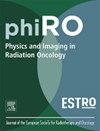Accuracy-dependent dose-constraints and dose-based safety margins for organs-at-risk in radiotherapy
IF 3.4
Q2 ONCOLOGY
引用次数: 0
Abstract
Background and purpose
Geometrical uncertainties in radiotherapy are generally accounted for by margins for tumors, but their effect on organs-at-risk (OARs) is often ignored. We developed a model that incorporates dose- and geometry-based uncertainties in OAR planning using dose constraints.
Materials and methods
Radiotherapy uncertainties cause real dose-volume histograms (DVHs) to spread around the planned DVH. With a published OAR dose constraint D(Vcrit) < Dcrit such that complication probability < Y%, real differences from planned Dcrit can be described by mean- (MDDcrit) and standard deviations (SDDcrit). Assuming complications are associated with the worst DVHs, New dose constraints that maintain complication probability can be derived for new treatments:Dcrit,New = Dcrit,publ + Φ−1(1 - Y%) * (SDDcrit,publ - SDDcrit,New) + (MDDcrit,publ - MDDcrit,New),with Φ−1(x) the inverse cumulative normal distribution function. Setting SDDcrit,New = MDDcrit,New = 0 in the recipe yields the “True” critical dose, and Dcrit,True - Dcrit,publ can be considered a dose-based safety margin (DSM).
As hypothetical example, we estimated MDDcrit and SDDcrit values by simulating geometric errors in our clinical treatment plans and adding dose-based uncertainty. Over 1000 OARs with 108 different regular- and hypo-fractionation constraints were simulated. We assumed accuracy SDs to change from 2.5mm/3% to 1.5mm/2%.
Results
Results varied per OAR, fractionation, and constraint-type. If our 2.5mm/3% MDDcrit and SDDcrit values approximated dose-constraint studies, on average the DSM would be 4.5 Gy (18%) and our dose constraints would increase with 1.2 Gy (5%).
Conclusions
We introduced a first model relating dose constraints and complication probabilities with treatment uncertainties and safety margins for OARs. Among other things, it quantified how higher constraints can be applied with increasing radiotherapy accuracy.
放射治疗中危险器官的准确度依赖剂量限制和剂量安全边际
背景和目的放射治疗中的几何不确定性通常由肿瘤的边缘来解释,但它们对危险器官(OARs)的影响往往被忽视。我们开发了一个模型,该模型结合了使用剂量约束的桨叶规划中基于剂量和几何的不确定性。材料和方法放射治疗的不确定性导致实际剂量-体积直方图(DVH)在计划的DVH周围扩散。已公布的OAR剂量限制D(Vcrit) <;这样,复杂概率<;Y%,与计划Dcrit的实际差异可以用均值(MDDcrit)和标准差(sdddcrit)来描述。假设并发症与最严重的dvh相关,则可以推导出维持新治疗并发症概率的新剂量约束:Dcrit,New = Dcrit,publ + Φ−1(1 - Y%) * (SDDcrit,publ - SDDcrit,New) + (MDDcrit,publ - MDDcrit,New), Φ−1(x)为逆累积正态分布函数。在配方中设置SDDcrit,New = MDDcrit,New = 0产生“True”临界剂量,Dcrit,True - Dcrit, public可被认为是基于剂量的安全边际(DSM)。作为假设的例子,我们通过模拟临床治疗计划中的几何误差并添加剂量不确定性来估计MDDcrit和sdddcrit值。模拟了1000多个具有108种不同规则和次分馏约束的桨。我们假设精度SDs从2.5mm/3%变化到1.5mm/2%。结果不同的桨、分级和约束类型的结果不同。如果我们的2.5mm/3% MDDcrit和sdddcrit值接近剂量约束研究,则平均DSM将为4.5 Gy(18%),我们的剂量约束将增加1.2 Gy(5%)。我们引入了第一个将剂量限制、并发症概率与治疗不确定性和安全边际联系起来的模型。除其他事项外,它量化了如何在提高放射治疗精度的情况下应用更高的约束。
本文章由计算机程序翻译,如有差异,请以英文原文为准。
求助全文
约1分钟内获得全文
求助全文
来源期刊

Physics and Imaging in Radiation Oncology
Physics and Astronomy-Radiation
CiteScore
5.30
自引率
18.90%
发文量
93
审稿时长
6 weeks
 求助内容:
求助内容: 应助结果提醒方式:
应助结果提醒方式:


